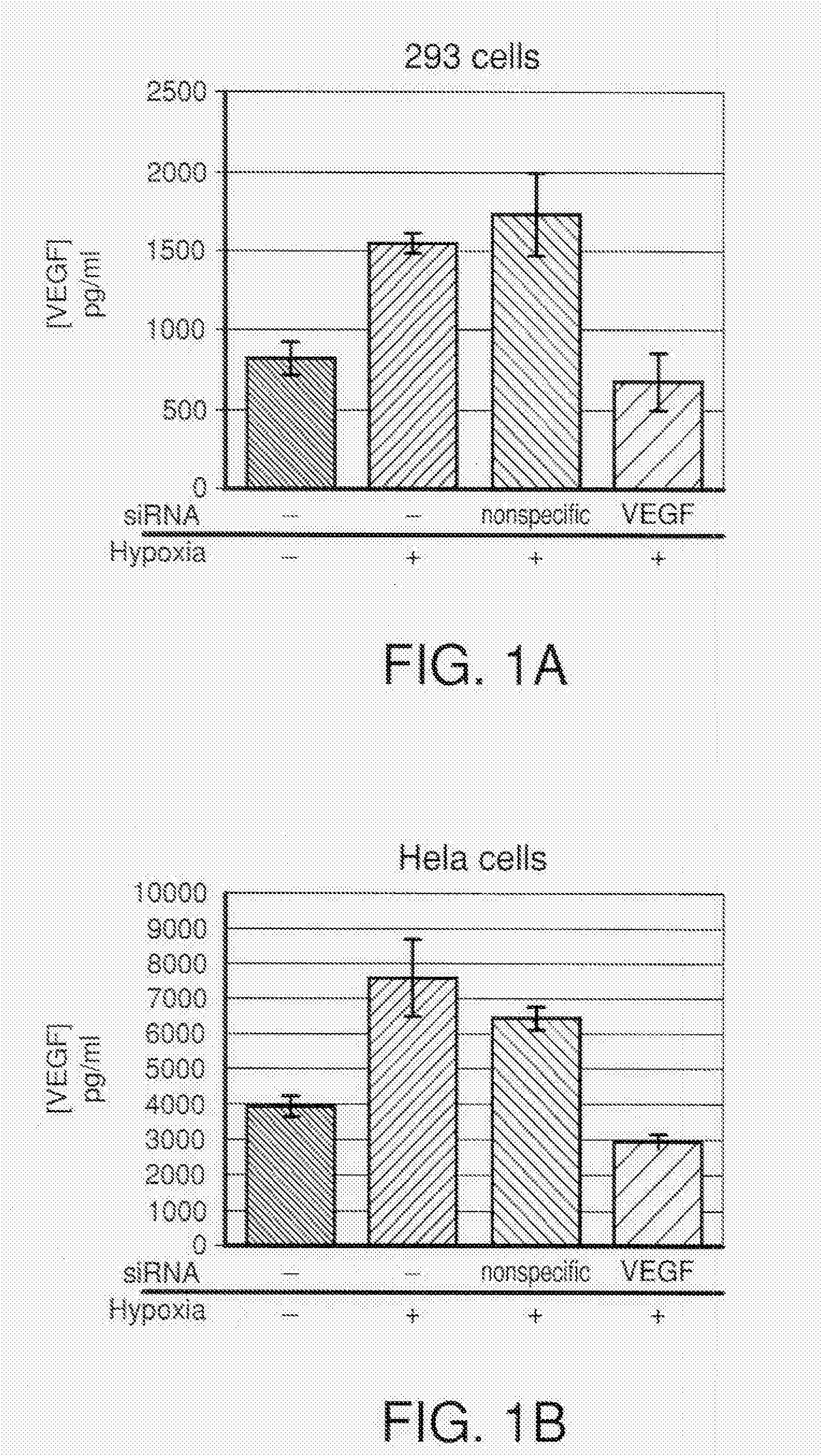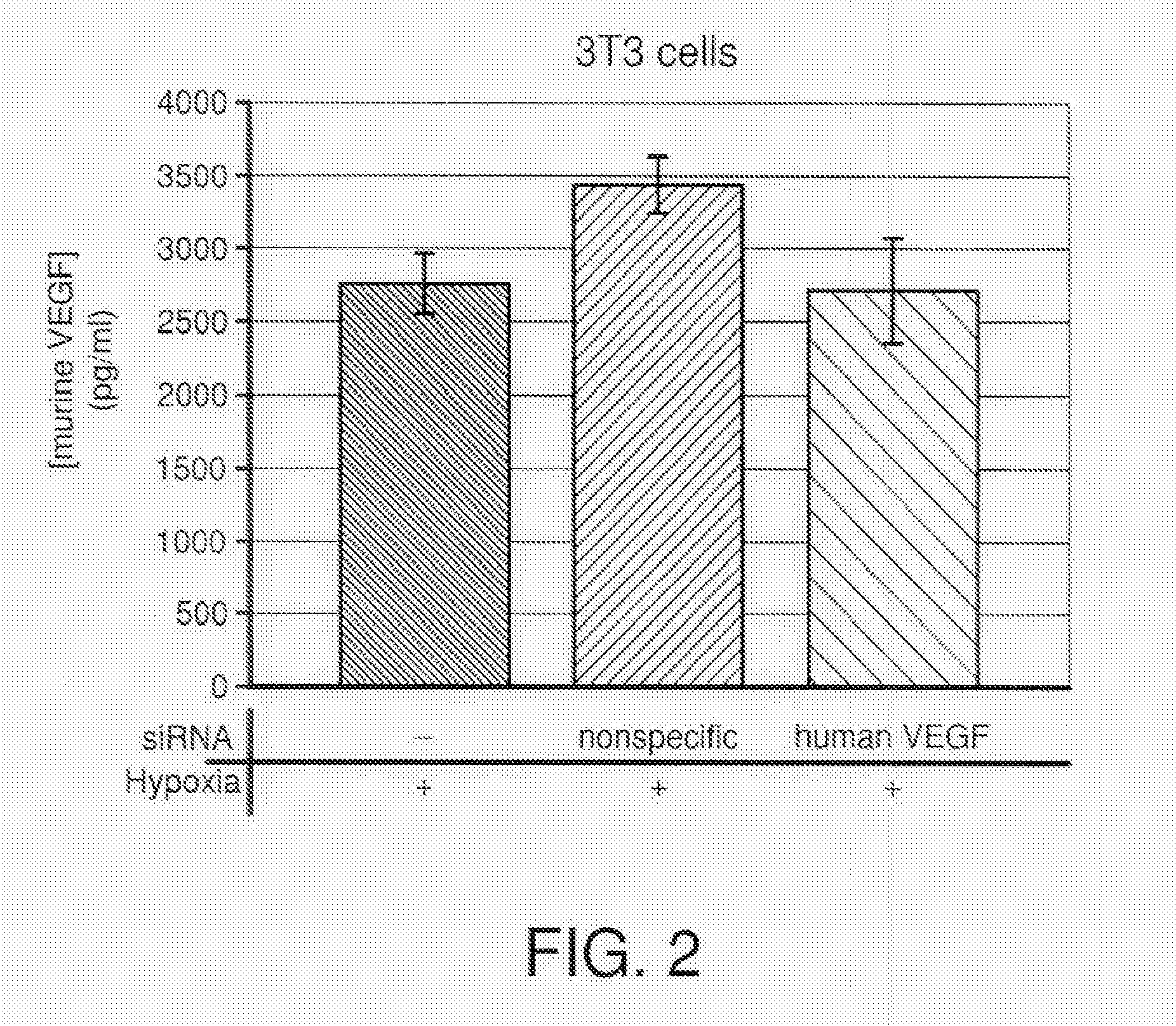COMPOSITIONS AND METHODS FOR siRNA INHIBITION OF ANGIOGENESIS
a technology of sirna and angiogenesis, which is applied in the direction of drug composition, peptide/protein ingredients, cardiovascular disorders, etc., can solve the problems of unsatisfactory anti-angiogenic therapy, abnormally high production of vegf by diseased tissue, and over-excited agents, and achieve the effect of inhibiting angiogenesis
- Summary
- Abstract
- Description
- Claims
- Application Information
AI Technical Summary
Benefits of technology
Problems solved by technology
Method used
Image
Examples
example 1
siRNA Transfection and Hypoxia Induction In Vitro
[0113] siRNA Design—A 19 nt sequence located 329 nt from the 5′ end of human VEGF mRNA was chosen as a target sequence: AAACCTCACCAAGGCCAGCAC (SEQ ID NO: 51). To ensure that it was not contained in the mRNA from any other genes, this target sequence was entered into the BLAST search engine provided by NCBI. The use of the BLAST algorithm is described in Altschul et al. (1990), J. Mol. Biol. 215: 403-410 and Altschul et al. (1997), Nucleic Acids Res. 25: 3389-3402, the disclosures of which are herein incorporated by reference in their entirety. As no other mRNA was found which contained the target sequence, an siRNA duplex was synthesized to target this sequence (Dharmacon Research, Inc., Lafayette, Co.).
[0114] The siRNA duplex had the following sense and antisense strands.
sense:(SEQ ID NO: 77)5′-accucaccaaggccagcacTT-3′.antisense:(SEQ ID NO: 78)5′-gugcuggccuuggugagguTT-3′.
[0115] Together, the siRNA sense and antisense strands form...
example 2
Effect of Increasing siRNA Concentration on VEGF Production in Human Cultured Cells
[0121] The experiment outlined in Example 1 was repeated with human 293, HeLa and ARPE19 cells using a range of siRNA concentrations from 10 to 50 nM. The ability of the Cand5 siRNA to down-regulate VEGF production increased moderately up to approximately 13 nM siRNA, but a plateau effect was seen above this concentration. These results highlight the catalytic nature of siRNA-mediated RNAi degradation of mRNA, as the plateau effect appears to reflect VEGF production from the few cells not transfected with the siRNA. For the majority of cells which had been transfected with the siRNA, the increased VEGF mRNA production induced by the hypoxia is outstripped by the siRNA-induced degradation of the target mRNA at siRNA concentrations greater than about 13 nM.
example 3
Specificity of siRNA Targeting
[0122] NIH 3T3 mouse fibroblasts were grown in 24-well plates under standard conditions, so that the cells were ˜50% confluent one day prior to transfection. The human VEGF siRNA Cand5 was transfected into a NIH 3T3 mouse fibroblasts as in Example 1. Hypoxia was then induced in the transfected cells, and murine VEGF concentrations were measured by ELISA as in Example 1.
[0123] The sequence targeted by the human VEGF siRNA Cand5 differs from the murine VEGF mRNA by one nucleotide. As can be seen in FIG. 2, the human VEGF siRNA has no affect on the ability to the mouse cells to up-regulate mouse VEGF after hypoxia. These results show that siRNA induced RNAi degradation is sequence-specific to within a one nucleotide resolution.
PUM
| Property | Measurement | Unit |
|---|---|---|
| number-average molecular weight | aaaaa | aaaaa |
| number-average molecular weight | aaaaa | aaaaa |
| volumes | aaaaa | aaaaa |
Abstract
Description
Claims
Application Information
 Login to View More
Login to View More - R&D
- Intellectual Property
- Life Sciences
- Materials
- Tech Scout
- Unparalleled Data Quality
- Higher Quality Content
- 60% Fewer Hallucinations
Browse by: Latest US Patents, China's latest patents, Technical Efficacy Thesaurus, Application Domain, Technology Topic, Popular Technical Reports.
© 2025 PatSnap. All rights reserved.Legal|Privacy policy|Modern Slavery Act Transparency Statement|Sitemap|About US| Contact US: help@patsnap.com



